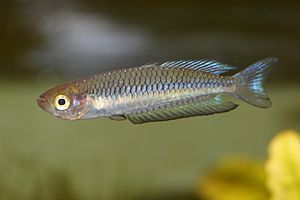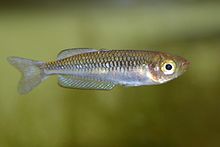Rhadinocentrus ornatus
| Rhadinocentrus ornatus | ||||||||||||
|---|---|---|---|---|---|---|---|---|---|---|---|---|

Male (Searys Creek) |
||||||||||||
| Systematics | ||||||||||||
|
||||||||||||
| Scientific name of the genus | ||||||||||||
| Rhadinocentrus | ||||||||||||
| Regan, 1914 | ||||||||||||
| Scientific name of the species | ||||||||||||
| Rhadinocentrus ornatus | ||||||||||||
| Regan , 1914 |
Rhadinocentrus ornatus is a slender freshwater fish in the rainbow fish family thatlivesin coastal waters in southern Queensland and northern New South Wales .
features
Rhadinocentrus ornatus are very variable in color, depending on their geographical origin. The silvery-transparent body is often bluish or reddish in color. The scales are relatively large and form a network pattern due to the often dark scales. Often a dark double stripe is visible in the middle of the body from head to tail. The back and neck shimmer neon blue, the fins are often reddish and with dark fin rays . The males are more vividly colored than the females and have a more extended caudal fin. During courtship, the males show a red courtship stripe from the tip of the mouth to the second dorsal fin or dorsal. The slender fish reach a maximum standard length of 5–6 cm, mostly about 4 cm.
Fin formula : D1 III-V, D2 I / 11-15, AI / 18-22, P 11-13
Distribution and habitat
Rhadinocentrus ornatus is endemic to the subtropical coastal waters east of the Great Dividing Range between Maryborough, Queensland and Coffs Harbor, New South Wales. It also occurs on the large sand islands off the coast, such as Fraser Island , Moreton Island (the type locality ) and North Stradbroke Island . There it lives in freshwater streams and rivers, ponds and dune lakes ( Wallum ). The water is typically darkly colored by humic substances and is acidic. The fish stay near roots and dead wood, overhanging or emerging vegetation.
The range is limited and fragmented so that there is no gene flow between many populations. Genetic studies have shown four such different populations that can be assigned to the following areas: (1) Byfield (Water Park Creek) to Tin Can Bay and Fraser Island, (2) Searys Creek (Rainbow Beach), (3) Noosa River to Brunswick River (NSW) with the islands of Bribie, Moreton and Stradbroke and (4) in northern NSW south of the Brunswick River. It often occurs with Nannoperca oxleyana and Pseudomugil mellis .
Threats lie in the destruction of the habitat and the like. a. by clearing for building land and in competing, imported Gambus ( Gambusia holbrooki ).
Way of life and reproduction
Rhadinocentrus ornatus lives in small groups and feeds omnivorously on terrestrial and aquatic insects and their larvae, small crustaceans and algae. He prefers to take food from the surface of the water.
The female spawns over several days, the eggs, which are a good millimeter in size, adhere to vegetation by means of “threads” until the larvae hatch after 7–10 days.
Others
In Australia, the local color variants of Rhadinocentrus ornatus have been popular aquarium fish for decades.
Individual evidence
- ↑ Ornate Rainbowfish on www.fishesofaustralia.net.au (accessed March 30, 2016)
- Jump up ↑ Page, TJ, Sharma, S. & Hughes, JM 2004. Deep phylogenetic structure has conservation implications for ornate rainbowfish (Melanotaeniidae: Rhadinocentrus ornatus) in Queensland, eastern Australia. Marine and Freshwater Research 55: 165-172.
Web links
- Rhadinocentrus ornatus on Fishbase.org (English)
- Ornate Rainbowfish on "Fishes of Australia"
- Adrian R. Tappin: Rhadinocentrus ornatus on "Home of the Rainbowfish" (English)
